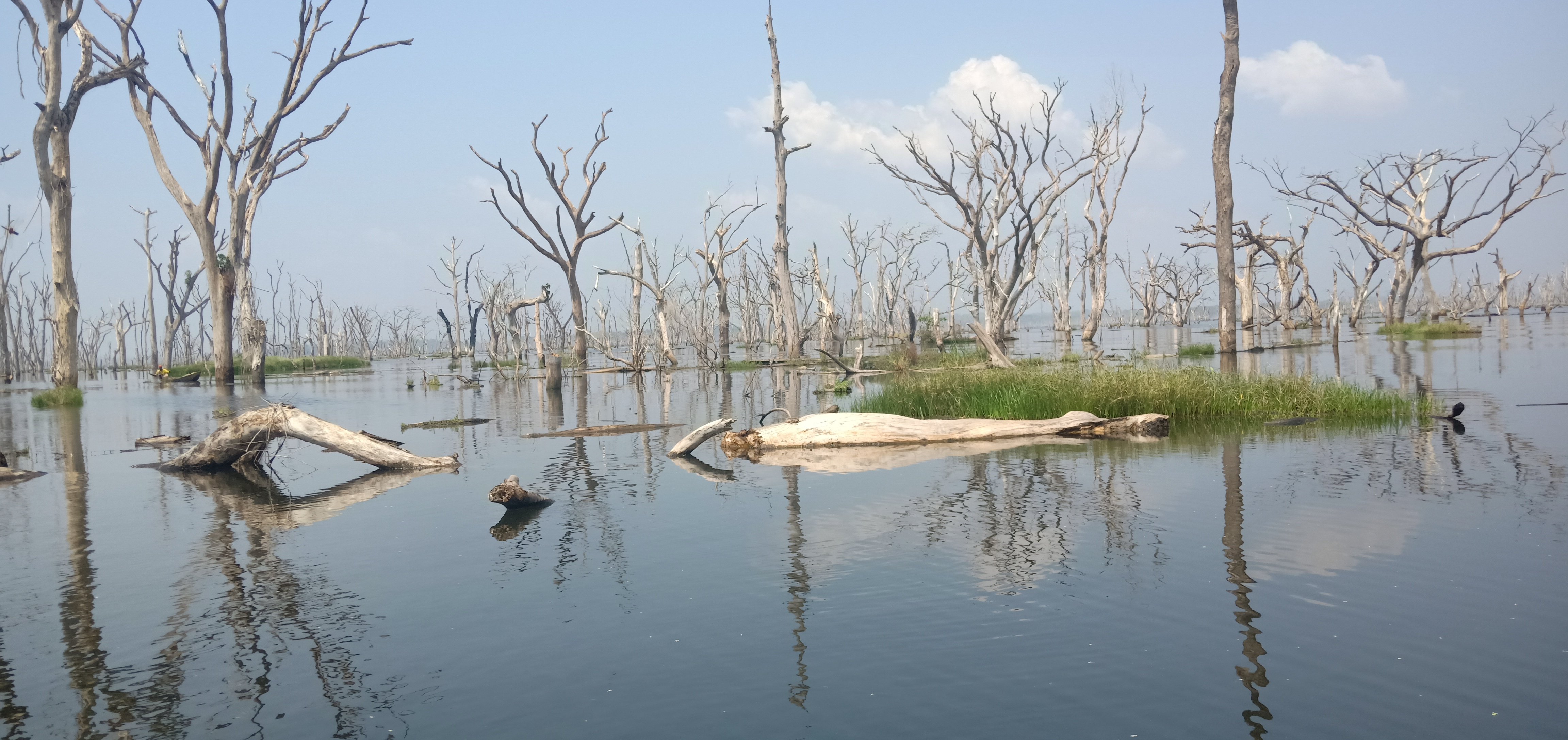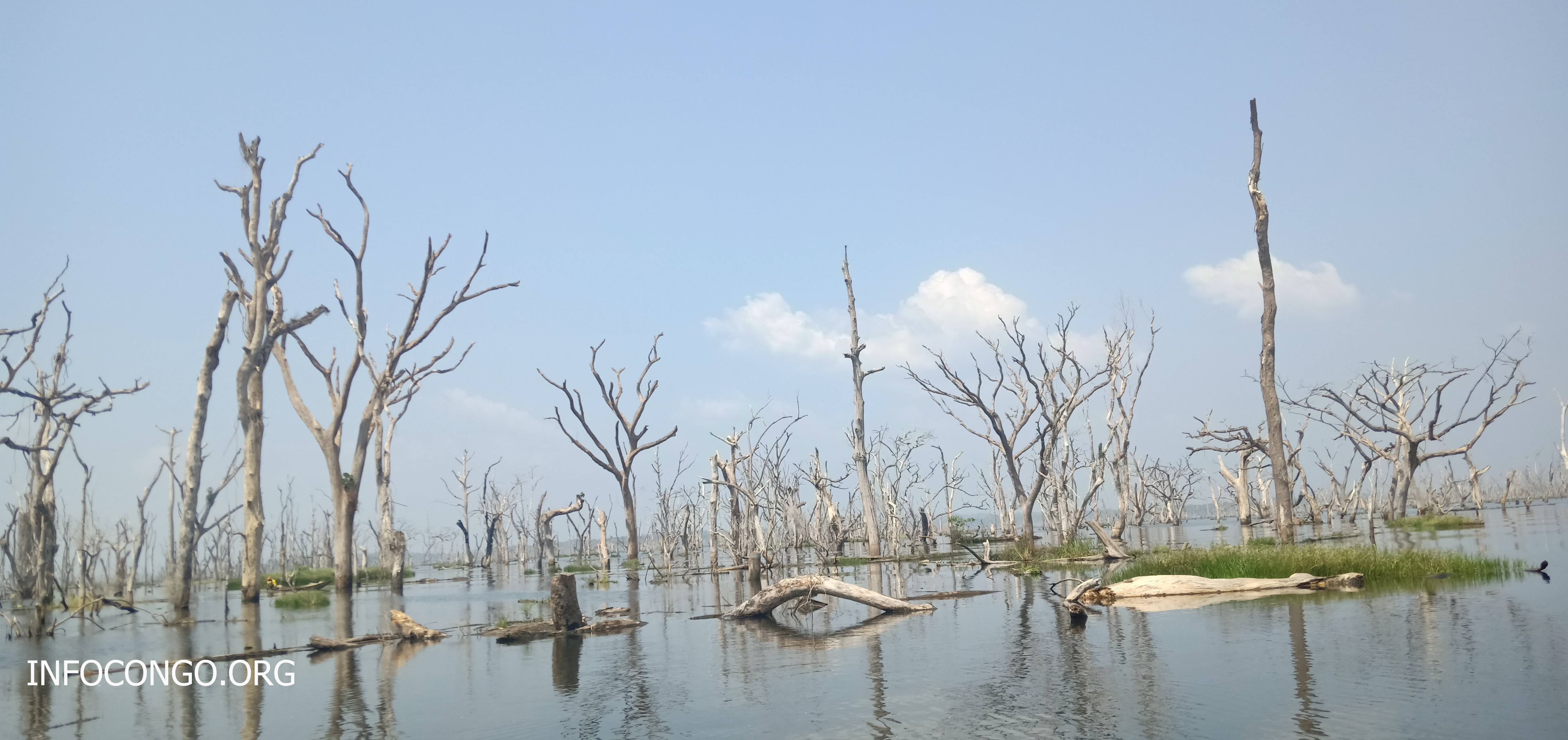Four years after it was launched, the Lom Pangar hydropower dam in Cameroon is full of floating wood and dead tree trunks resulting to the emission of the methane, a harmful substance exacerbating climate change.
Ouami/Cameroon – A makeshift boat comes to a stop after colliding with a tree trunk. That is about fifteen kilometers from the landing in Ouami, a village located about 100 kilometers from Bertoua, the capital of the East Region of Cameroon. The engine of the wooden canoe goes off. A dozen passengers made up of men, women, and children can barely disguise their panic.
At both ends of the canoe, the two young paddlers look rather serene. They consult each other in fulfuldé, an indigenous language spoken by Peul communities in the north of Cameroon. Then after the discussion, both deep their paddles into the water and perform a few maneuvers. Fifteen minutes is enough to clear the obstacle and restart the engine. The travelers hive a sigh of relief, as the journey resumes.

Lom Pangar Dam Plant, floating woods and dead trees in the lake.
Pictures by Madeleine Ngeunga/InfoCongo
While this might look scary, it is instead a daily ritual for the majority of this fishing community, making a living out of the close to 590 square kilometers of the Lom Pangar hydroelectric dam. Throughout the navigation on the lake, the boatmen zigzagged to avoid colliding with branchless-tree trunks.
Although most of them have motorized canoes, they also use their wooden paddles to push floating woods that keep popping up along the way. On every trip, it is the same scenario. Not only does this floating wood handicap the navigation of the fishermen, but it also constitutes one of the most tangible environmental impacts of the Lom Pangar reservoir dam.
“There is a lot of deadwood in this reservoir. The river bed was widened when the dam was filled, and this suffocated the underground trees”, Phanuella Djateng, Project Manager at SAILD.
Since 2018, SAILD, an environmental non-governmental organization, has been monitoring forest change in the Deng Deng National Park. The Lom Pangar dam is a major threat to the Deng Deng National Park. The team combines fieldwork and satellite imagery data from Global Forest Watch and the Cameroon Forest Atlas to assess the socio-environmental impact of the dam.
Tree cover loss in the Hydro-electric Lom Pangar Dam area between 2012 to 2018
“There is a lot of deadwood in this reservoir. The river bed was widened when the dam was filled, and this suffocated the underground trees, says Phanuella Djateng, Project Manager at SAILD.
Drowned wood, a failure
To mitigate this environmental impact and valorize the timber of the reservoir area, the Environmental and Social Management Plan (ESMP) of the Lom Pangar project planned the timber harvesting and biomass removal within the reservoir before filling up the reservoir.
“Before the Lom Pangar dam, this reservoir was only made up of forest. Researchers warned during the environmental impact assessment that when this forest is flooded, there would be a decomposition of vegetation resulting in greenhouse gas emissions. We envisaged this in our studies,” says Alphonse Emadak, the Sub Director of Environment and Quality at Electricity Development Corporation (EDC). EDC is the company overseeing the Lom Pangar Hydropower Dam.
“The vegetation removal within the reservoir can be considered a major failure since it did not contribute to the valorization of this wood”, audit report.
“In 2013, a study by French consultancy firm, ONF International had proposed nearly 6000 hectares along the Lom and Pangar rivers to be deforested in the hope of harvesting 800,000 metric cubes of marketable wood,” recalls the Independent Environmental and Social Technical Auditor of the Lom Pangar Dam (ATESI).
“The vegetation removal within the reservoir can be considered a major failure since it did not contribute to the valorization of this wood.” says the auditor. Barely 2% of the flooded area of the Lom Pangar reservoir dam was cleared before it was filled, according to the independent Environmental and Social Audit reports.
“The late start in removing the vegetation on a minimal area (600 hectares or barely 2% of the flooded area) did not make it possible to valorize the existing wood,” says the audit report. As a result, barely 1% of the forest resource was removed from the area to be flooded before the Lom Pangar reservoir was filled.
“If 2,000 cubic meters of wood (barely 1% of the resource) were extracted from the area to be cleared, no wood was auctioned and therefore not valued,” points out ATESI.
One of the critical points of the ESMP for the Lom Pangar project was the awarding of contracts for the Sale of Standing Volume. However, the auditor notes a large gap between the objectives set and the activities carried out.

Lom Pangar Dam, the landing point was the least cleared.
Pictures by Madeleine Ngeunga/ InfoCongo
“Initially planned over 2500 ha, only 610 ha were finally allocated to 3 companies which started their activities in March-April 2015. At the beginning of 2016, the three areas had been irregularly cleared with many unburned residues”, says one of the audit reports. In addition, “most of the work took place during the rainy season, which made the process of timber recuperation within the reservoir considerably more complex. The landing point was the least cleared. Many wood parks remain either isolated, flooded, or on the direct edge of the reservoir,” the auditor points out.
Harmful Delays
Environmentalist Justin Chekoua, a project manager at Forests and Rural Development (FODER) is not surprised by these results. Chekoua worked for a few years as an environmentalist in the Lom Pangar project.
“According to the regulatory requirements he signed with the World Bank, EDC’ duty was to remove all timber and vegetation in the reservoir of the power plant before releasing the water. However, compared to the initial programming that had been done, they were at least two years late in contracting the companies in charge of the timber recuperation within the reservoir before its filling. This delay hampered the work of the companies because when they started logging, the water was already flooding, and the companies were forced to leave,” explains Chekoua.

There is enough decomposed vegetation in the Lom Pangar dam.
Pictures by Madeleine Ngeunga/ InfoCongo
“There is enough decomposed vegetation in the Lom Pangar dam and it’s producing methane”, says Chekoua. The ESMP pointed out that the public call for tenders for timber recuperation through Sales of Standing Volume may be unsuccessful.
“Greenhouse gas emissions are estimated to increase by 2-3% if no wood recovery takes place, and the risks of induced impacts in the area will be reduced”, according to the ESMP.
Once considered as “clean energy source”, large hydroelectric dams are now being questioned. International Rivers states that “big dams are so harmful that they can’t be called green.” Constructed in tropical forest regions, such as the Congo Basin, these dams have an impact on global warming.
They produce greenhouse gas emissions such as carbon dioxide due to forest loss and methane gas that results from the rotting vegetation, drowned after the filling up of the reservoir.
“Dams and reservoirs are responsible for almost a quarter of all human-caused methane emissions – that is four percent of all human-caused warming,” according to the organization International Rivers.
Scientists estimate that methane gas is at least twenty times more potent than carbon dioxide in contributing to the greenhouse effect.
Editor’s note: This report is one of the series of storytelling and Data visualizations about Forest Change and Forest management in Cameroon. Produced with the financial and technical support of Global Forest Watch, this is part of the Global Forest Watch Tech Fellowship 2019, Global Forest Watch do not have any editorial influence on this.

BEL ARTICLE. Il est trop riche en information, bien fouillé, structuré et agréable à lire. Chapeau à l’artiste
Riche, détaillé et illustratif. Je me suis délectée.
Bravooo! Ce que révèle l’article c’est bien la face invisible de cet investissement. De nombreuses sources croisées de manière cohérence. Je m’en suis abreuvés. Nous attendons la suite… Question:les riverains du lacs sont ils conscients du danger de la présence de ce bois mort? Thank you
Bonjour.
Merci pour cet éclairage bien que triste pour nos populations.
Que disent les gestionnaires de ce cite ? Que pense les autorités compétentes ?.. pourtant ils existent bien des solutions simples.
Ferdinand OLINGA
Office nationale des forêts ( France ) service travaux